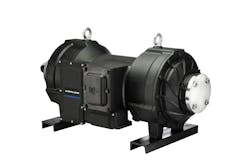Pushing the Chiller Performance and Sustainability Envelope
Key Highlights
- Oil-free centrifugal compressors eliminate oil management issues, reducing maintenance costs and operational disruptions in data center cooling systems.
- Designed with built-in redundancy and self-levitating fluid films, these compressors ensure high reliability even during power outages, minimizing downtime.
- Decoupling compressors from power electronics enhances serviceability, enabling easier access and faster maintenance, which boosts overall system resilience.
The exponential growth of artificial intelligence (AI) is introducing cooling challenges in data center applications. AI requires high-density computing driven by graphics processing units (GPUs), which consume more energy and produce additional heat in an already power- and heat-intensive environment. Maintaining uptime requires reliable cooling strategies, often with robust air-cooled chillers in the 400- to 500-ton capacity range.
In recent years, original equipment manufacturers (OEMs) of data center chillers have started specifying oil-free compression technology for its many advantages: improved application reliability, increased energy efficiencies, lower servicing requirements, and minimal maintenance disruptions. But recent advancements in oil-free compression technology have expanded these benefits to offer numerous advantages for data center chiller applications, such as:
- Improving performance and energy efficiencies across a broader capacity envelope;
- Easily scaling capacities to precisely and economically meet application requirements (i.e., from low-load to high-lift) by combining multiple compressors on a single circuit;
- Addressing application challenges in high-ambient conditions (i.e., hot, arid conditions where water is scarce and air cooling is required);
- Recovering and repurposing excess heat for supplemental space and water heating; and
- Enhancing operational sustainability while enabling the low-global warming potential (GWP) refrigerant transition.
Chiller reliability is essential for maintaining uptime for data center operators. Operators are also seeking to lower their operational carbon footprints in the face of ever-increasing data center power and resource consumption.
Achieving these performance and operational breakthroughs starts with an evolution in oil-free compression. The Copeland oil-free centrifugal compressor with Aero-lift™ bearing technology is one example: it’s specifically designed to deliver the next generation of data center chiller serviceability, sustainability, efficiency and reliability improvements.
Oil-Free Equals Worry-Free Operability
The appeal of oil-free compression technology in data center chiller applications is demonstrable. By eliminating the traditional challenges of oil management, oil-free compressors alleviate common data center operational concerns, including:
- Minimizing operational disruptions and maintenance costs for scheduled servicing;
- Avoiding inevitable performance degradations and the potential for chiller failure; and
- Maintaining consistent energy efficiencies throughout the system lifecycle.
Finding an oil-free centrifugal compressor that can maximize these benefits while improving overall compressor and chiller serviceability and flexibility is key. Look for a design that decouples the compressor from the power electronics — i.e., variable frequency drive (VFD) — enabling technicians to access it or the drive independently. Improving serviceability for technicians translates into lower costs and increased uptime for operators, allowing flexibility to configure chiller installations for maximum resiliency.
Built for Data Center Reliability Standards
Uptime is critical in data center operations. It’s why computing power and chiller infrastructures are built with safeguards to minimize the potential negative impacts of a power outage. Oil-free centrifugal compressors are designed with built-in redundancy to ensure reliable performance, compared to oil-free compressors with magnetic levitation bearings.
In the event of a power disruption, the compressor can gradually come to a stop without the need for backup bearings or complex sensors and controls. A self-levitating fluid film provides frictionless performance in tens of thousands of power drop/restart scenarios, effortlessly withstanding disruptions while enabling a fast ramp-up and restart.
The fact that there are fewer moving parts both inside and outside the compressor means there are less potential failure points, resulting in improved reliability. Oil-free centrifugal technology is not sensitive to power interruptions, and mitigation technologies — such as an uninterruptible power supply (UPS) — are not required to maintain robust performance.
Maximizing Efficiency
Data center chillers are designed to meet a wide range of application capacity requirements and operate efficiently in all ambient conditions — from part-load in cool climates to high-lift in hot ambient temperatures. Chiller OEMs strive to achieve these goals while minimizing applied costs.
For example, these types of compressors can support lighter load capacities and lower pressures to deliver significant energy efficiency gains — without the need for a refrigerant pump. These compressors can also scale to meet the chiller requirements at the higher side of the envelope.
By combining multiple oil-free centrifugal compressors in their designs, OEMs can achieve a 400- to 500-ton capacity range on a single circuit.
Additionally, matching the VFD power rating to specific application requirements enables the compressor to meet OEM chiller specifications across the entire operating envelope — all while maintaining standardization of the same oil-free centrifugal compressor.
Lowering the Carbon Footprint of Data Center Cooling
As data center power consumption continues to rise with the growth of AI, operators need new cooling strategies that can take the heat while lowering their carbon footprints. Energy-efficient, environmentally friendly, air-cooled chillers that leverage lower-GWP refrigerants are evolving to meet these demands while reducing the need for water and/or natural resource consumption (i.e., free cooling).
An oil-free centrifugal compressor with its high-lift capacities and high-speed capabilities allows data centers to leverage air-cooled chillers, even in hot ambient conditions. Operators can lower their Scope 1 greenhouse gas (GHG) emissions by selecting one of three next-generation, lower-GWP refrigerants: R-1234ze, R-515B or R-513A. Its best-in-class performance and high efficiency across the envelope help operators reduce Scope 2 emissions and shrink their power consumption carbon footprint.
One option for dealing with the excess data center heat generated by AI-powered servers is to capture and repurpose it via a heat reclaim system configuration. By transforming heat into a usable resource, the compressor can help operators transition from fossil fuel-powered boilers and decarbonize their operations.
Welcome to a new era of data center cooling.
About the Author
Mike Oakley
Mike Oakley is the director of Oil-Free Centrifugal Compression Solutions at Copeland.


